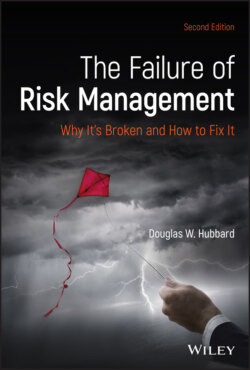The Failure of Risk Management

Реклама. ООО «ЛитРес», ИНН: 7719571260.
Оглавление
Douglas W. Hubbard. The Failure of Risk Management
Table of Contents
List of Tables
List of Illustrations
Guide
Pages
The Failure of Risk Management. WHY IT'S BROKEN AND HOW TO FIX IT
About the Author
Preface
Acknowledgments
CHAPTER 1 Healthy Skepticism for Risk Management
A “COMMON MODE FAILURE”
KEY DEFINITIONS: RISK MANAGEMENT AND SOME RELATED TERMS
DEFINITION OF RISK
DEFINITION OF MANAGEMENT
DEFINITION OF RISK MANAGEMENT
DEFINITION OF RISK ANALYSIS
WHAT FAILURE MEANS
SCOPE AND OBJECTIVES OF THIS BOOK
NOTES
CHAPTER 2 A Summary of the Current State of Risk Management
A SHORT AND ENTIRELY-TOO-SUPERFICIAL HISTORY OF RISK
CURRENT STATE OF RISK MANAGEMENT IN THE ORGANIZATION
CURRENT RISKS AND HOW THEY ARE ASSESSED
Expert Intuition, Checklists, and Audits
The Risk Matrix
Other Qualitative Methods
Mathematical and Scientific Methods
NOTES
CHAPTER 3 How Do We Know What Works?
ANECDOTE: THE RISK OF OUTSOURCING DRUG MANUFACTURING
WHY IT'S HARD TO KNOW WHAT WORKS
AN ASSESSMENT OF SELF-ASSESSMENTS
POTENTIAL OBJECTIVE EVALUATIONS OF RISK MANAGEMENT
The Big Experiment
Direct Evidence of Cause and Effect
Component Testing
Formal Errors
A Check of Completeness
Answering the Right Question
WHAT WE MAY FIND
RISK MANAGEMENT SUCCESS-FAILURE SPECTRUM
NOTES
CHAPTER 4 Getting Started: A Simple Straw Man Quantitative Model
A SIMPLE ONE-FOR-ONE SUBSTITUTION
THE EXPERT AS THE INSTRUMENT
A QUICK OVERVIEW OF “UNCERTAINTY MATH”
ESTABLISHING RISK TOLERANCE
SUPPORTING THE DECISION: A RETURN ON MITIGATION
MAKING THE STRAW MAN BETTER
NOTE
CHAPTER 5 The “Four Horsemen” of Risk Management: Some (Mostly) Sincere Attempts to Prevent an Apocalypse
ACTUARIES
WAR QUANTS: HOW WORLD WAR II CHANGED RISK ANALYSIS FOREVER
ECONOMISTS
MANAGEMENT CONSULTING: HOW A POWER TIE AND A GOOD PITCH CHANGED RISK MANAGEMENT
HOW TO SELL ANALYSIS PLACEBOS (THAT IS, SNAKE OIL)
COMPARING THE HORSEMEN
MAJOR RISK MANAGEMENT PROBLEMS TO BE ADDRESSED
SIX CHALLENGES FOR RISK MANAGEMENT
NOTES
CHAPTER 6 An Ivory Tower of Babel: Fixing the Confusion about Risk
UNCERTAINTY VERSUS RISK AND THE MEASUREMENTS OF EACH
THE FRANK KNIGHT DEFINITION
KNIGHT'S INFLUENCE IN FINANCE AND PROJECT MANAGEMENT
A CONSTRUCTION ENGINEERING DEFINITION
RISK AS EXPECTED LOSS
DEFINING RISK TOLERANCE
DEFINING PROBABILITY
ENRICHING THE LEXICON
NOTES
CHAPTER 7 The Limits of Expert Knowledge: Why We Don't Know What We Think We Know about Uncertainty
THE RIGHT STUFF: HOW A GROUP OF PSYCHOLOGISTS MIGHT SAVE RISK ANALYSIS
MENTAL MATH: WHY WE SHOULDN'T TRUST THE NUMBERS IN OUR HEADS
“CATASTROPHIC” OVERCONFIDENCE
THE MIND OF “ACES”: POSSIBLE CAUSES AND CONSEQUENCES OF OVERCONFIDENCE
INCONSISTENCIES AND ARTIFACTS: WHAT SHOULDN'T MATTER DOES
ANSWERS TO CALIBRATION TESTS
Answers to Exhibit 7.1
Answers to Exhibit 7.3
NOTES
CHAPTER 8 Worse Than Useless: The Most Popular Risk Assessment Method and Why It Doesn't Work
A FEW EXAMPLES OF SCORES AND MATRICES
DOES THAT COME IN “MEDIUM”?: WHY AMBIGUITY DOES NOT OFFSET UNCERTAINTY
UNINTENDED EFFECTS OF SCALES: WHAT YOU DON'T KNOW CAN HURT YOU
Range Compression
Presumption of Regular Intervals
Presumption of Independence
Partition Dependence
Conflation with Risk Aversion
Summarizing the Research on Risk Matrices
DIFFERENT BUT SIMILAR-SOUNDING METHODS AND SIMILAR BUT DIFFERENT-SOUNDING METHODS
They Sound Like Scores, but They Aren't (and They Work)
Methods that Aren't Exactly Scoring but Address (Necessarily) Subjective Preferences
They Don't Seem Like Scores, but They Are
NOTES
CHAPTER 9 Bears, Swans and Other Obstacles to Improved Risk Management
ALGORITHM AVERSION AND A KEY FALLACY
ALGORITHMS VERSUS EXPERTS: GENERALIZING THE FINDINGS
A NOTE ABOUT BLACK SWANS
MAJOR MATHEMATICAL MISCONCEPTIONS
Fundamental Misconceptions about Probability
Misconceptions about Statistical Tests
Miscellaneous Myths about Simulations
WE'RE SPECIAL: THE BELIEF THAT RISK ANALYSIS MIGHT WORK, BUT NOT HERE
NOTES
CHAPTER 10 Where Even the Quants Go Wrong: Common and Fundamental Errors in Quantitative Models
A SURVEY OF ANALYSTS USING MONTE CARLOS
THE RISK PARADOX
THE RISK PARADOX
Too Uncertain to Model Quantitatively?
“Too Unique” to Model Quantitatively?
THE MOUNT ST. HELENS FALLACY
FINANCIAL MODELS AND THE SHAPE OF DISASTER: WHY NORMAL ISN'T SO NORMAL
SIMPLE RANDOM SURVEY EXAMPLE USING A NORMAL DISTRIBUTION
FOLLOWING YOUR INNER COW: THE PROBLEM WITH CORRELATIONS
THE MEASUREMENT INVERSION
THE MEASUREMENT INVERSION
IS MONTE CARLO TOO COMPLICATED?
NOTES
CHAPTER 11 Starting with What Works
SPEAK THE LANGUAGE
Quantifying the Appetite for Risk
Break It Down, Then Do the Math
The Arithmetic of Uncertainty and Monte Carlo
Why NASA Assesses Uncertainty with Monte Carlos
GETTING YOUR PROBABILITIES CALIBRATED
The Equivalent Bet
More Calibration Strategies
The Results of Calibration Training
SUMMARY OF METHODS TO CALIBRATE PROBABILITY ESTIMATES
USING DATA FOR INITIAL BENCHMARKS
It's Been Measured Before
You Have More Data Than You Think
You Need Less Data Than You Think
A Reference Class Error: Revisiting the Turkey
CHECKING THE SUBSTITUTION
Be as Complete as Practical
Now, Apply a Filter
SIMPLE RISK MANAGEMENT
Risk Mitigation
NOTES
CHAPTER 12 Improving the Model
EMPIRICAL INPUTS
The Value of Information
OVERVIEW OF INFORMATIONAL VALUE
Updating Uncertainty with Bayes' Theorem
BAYES' THEOREM
BINOMIAL PROBABILITY IN EXCEL
A Probability of Probabilities: The Beta Distribution
Using Near Misses to Assess Bigger Impacts
ADDING DETAIL TO THE MODEL
Vertical Decomposition
Horizontal Decomposition
Z Decompositions
Just a Few More Distributions
Correlations and Dependencies Between Events
ADVANCED METHODS FOR IMPROVING EXPERT'S SUBJECTIVE ESTIMATES
Reducing Expert Inconsistency
Performance Weights
OTHER MONTE CARLO TOOLS
SELF-EXAMINATIONS FOR MODELERS
NOTES
CHAPTER 13 The Risk Community: Intra- and Extra-organizational Issues of Risk Management
GETTING ORGANIZED
Who's in Charge?
Selling Better Risk Management to Stakeholders
MANAGING THE MODEL
INCENTIVES FOR A CALIBRATED CULTURE
A Metric for the Performance of a Forecaster
Market-based Incentives?
Incentivizing the Right Behavior
EXTRAORGANIZATIONAL ISSUES: SOLUTIONS BEYOND YOUR OFFICE BUILDING
Growing the Profession
Improving the Regulatory Environment
Growing the Society
PRACTICAL OBSERVATIONS FROM TRUSTMARK
FINAL THOUGHTS ON QUANTITATIVE MODELS AND BETTER DECISIONS
NOTES
APPENDIX Additional Calibration Tests and Answers
Index
WILEY END USER LICENSE AGREEMENT
Отрывок из книги
Second Edition
DOUGLAS W. HUBBARD
.....
Long definition: The identification, analysis, and prioritization of risks followed by coordinated and economical application of resources to reduce, monitor, and control the probability and/or impact of unfortunate events
Shorter definition: Being smart about taking chances
.....